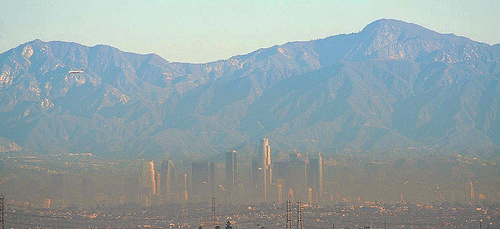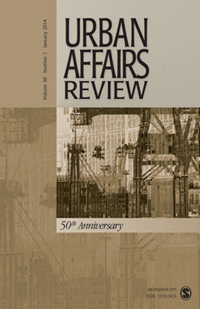Our job, as outdoor educators, is to figure out ways to inspire our students, get them excited about the environment, and make a lasting impression. In order to do this, we have to figure out ways to tie everything we do and say back to their lives in the city. Every single one of our students in the greater Los Angeles area has witnessed air pollution firsthand.
 Southern California has an infamous air pollution problem. It has long been assumed that the abundance of air pollution in the region is wide spread and the effects on people are consistent across the region. For example, the portion of the people in Southern California who have been diagnosed with asthma at some point in their lives is significantly higher than the rest of the United States. 1
Southern California has an infamous air pollution problem. It has long been assumed that the abundance of air pollution in the region is wide spread and the effects on people are consistent across the region. For example, the portion of the people in Southern California who have been diagnosed with asthma at some point in their lives is significantly higher than the rest of the United States. 1

Want to see pollution levels in your zip code? Here’s the California Communities Environmental Health Screening Tool.
Another study used air toxicity readings along with cancer toxicity information to estimate the lifelong cancer risk rates for people in Southern California. The results found that, as assumed, the cancer risk from outdoor air pollutants for all residents was very high. 2
This same study also found that African Americans, Asians, and Latinos had a much higher-than-average risk of cancer from air pollutants because of where they lived. 2
 This information, presented in the Urban Affairs Review Journal, reports that these minority groups lived in neighborhoods near highways, power plants, or away from areas with public transportation. The data states that one-third of Southern California’s minority populations live in the areas with the highest cancer risk, while only 15% of the caucasian population live in those areas. 4 When a disproportionate number of minorities are affected by environmental hazards it becomes an issue of environmental justice.
This information, presented in the Urban Affairs Review Journal, reports that these minority groups lived in neighborhoods near highways, power plants, or away from areas with public transportation. The data states that one-third of Southern California’s minority populations live in the areas with the highest cancer risk, while only 15% of the caucasian population live in those areas. 4 When a disproportionate number of minorities are affected by environmental hazards it becomes an issue of environmental justice.
The environmental justice movement originated in the United States in the 1980s as minority communities became increasingly frustrated with the disproportionate number of hazardous industries in their neighborhoods compared to wealthier, predominantly caucasian neighborhoods. Often these poorer communities are faced with hazardous and polluting sites, such as landfills, and suffer disproportionately from environmental impacts because they do not have the political or social power to combat them. This concept of environmental justice is that everyone deserves the right to a clean healthy environment and that everyone deserves a right to participate in environmental decision-making in their community regardless of socioeconomic class or race. 5
Environmental Justice…will be achieved when everyone enjoys the same degree of protection from environmental and health hazards and equal access to the decision-making process to have a healthy environment in which to live, learn, and work. 6
 There is hope; the governmental process, with assistance from the Environmental Protection Agency, is supporting environmental justice and making positive steps in Southern California. Last year 90% of the EPA’s enforcement actions in LA County were in minority communities. 7 San Bernardino County has recently rolled out an asthma prevention and education program in low economic neighborhoods. 8
There is hope; the governmental process, with assistance from the Environmental Protection Agency, is supporting environmental justice and making positive steps in Southern California. Last year 90% of the EPA’s enforcement actions in LA County were in minority communities. 7 San Bernardino County has recently rolled out an asthma prevention and education program in low economic neighborhoods. 8
So, while studies state that minority communities tend to have higher environmental hazards, our political system is showing our students, the leaders and citizens of tomorrow, that if we work together we can learn how to live on one healthy planet.
Our Environmental Awareness class uses a fun activity, Trash Toss, to illustrate the concept of different communities trying to get rid of their pollutants and trash. Nobody wants pollution in their own backyard, so we all work hard to find a good place for it far away from home. But what happens when our trash ends up in someone else’s backyard? How do they feel? This illustrated and discussed human empathy and compassion is an important part of the teaching, and growing process for our students.
At High Trails Outdoor Science School, we literally force our instructors to write about elementary outdoor education, teaching outside, learning outside, our dirty classroom (the forest…gosh), environmental science, outdoor science, and all other tree hugging student and kid loving things that keep us engaged, passionate, driven, loving our job, digging our life, and spreading the word to anyone whose attention we can hold for long enough to actually make it through reading this entire sentence. Whew…. www.dirtyclassroom.com
- California Environmental Protection Agency, Asthma and Air Pollution, http://www.arb.ca.gov/research/asthma/asthma.htm (13 November 2013). ↩
- Morello-Frosch, Rachel et al. “Environmental Justice and Southern California’s ‘Riskscape: The Distribution of Air Toxics Exposures and Health Risks Among Diverse Communities,’ Urban Affairs Review 36:4 (2001): 551-78. ↩
- Morello-Frosch, Rachel et al. “Environmental Justice and Southern California’s ‘Riskscape: The Distribution of Air Toxics Exposures and Health Risks Among Diverse Communities,’ Urban Affairs Review 36:4 (2001): 551-78. ↩
- Morello-Frosch, Rachel et al. “Environmental Justice and Southern California’s ‘Riskscape: The Distribution of Air Toxics Exposures and Health Risks Among Diverse Communities,’ Urban Affairs Review 36:4 (2001): 551-78. ↩
- Capacity Global, Environmental Justice: A Snapshot, http://www.capacity.org.uk/downloads/ snapshot_for_ej.pdf (17 May 2012). ↩
- http://www.epa.gov/compliance/ej/ ↩
- US Environmental Protection Agency – Pacific Southwest Region 9, Environmental Justice, http://www.epa.gov/socal/justice.html/ (13 November 2013). ↩
- US Environmental Protection Agency, “EPA Awards $60,000 in Environmental Justice Grants to Southern California Projects”, http://yosemite.epa.gov/opa/admpress.nsf/0/79D285C90585C1C985257BE3 0063BD9F (13 November 2013). ↩

Comments are closed.